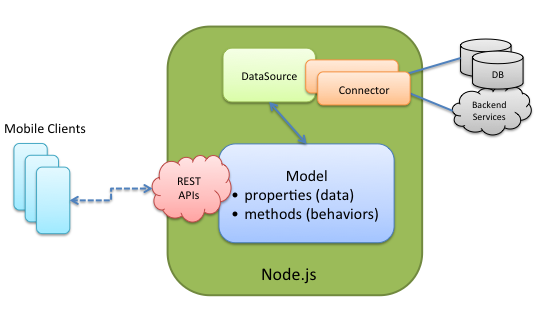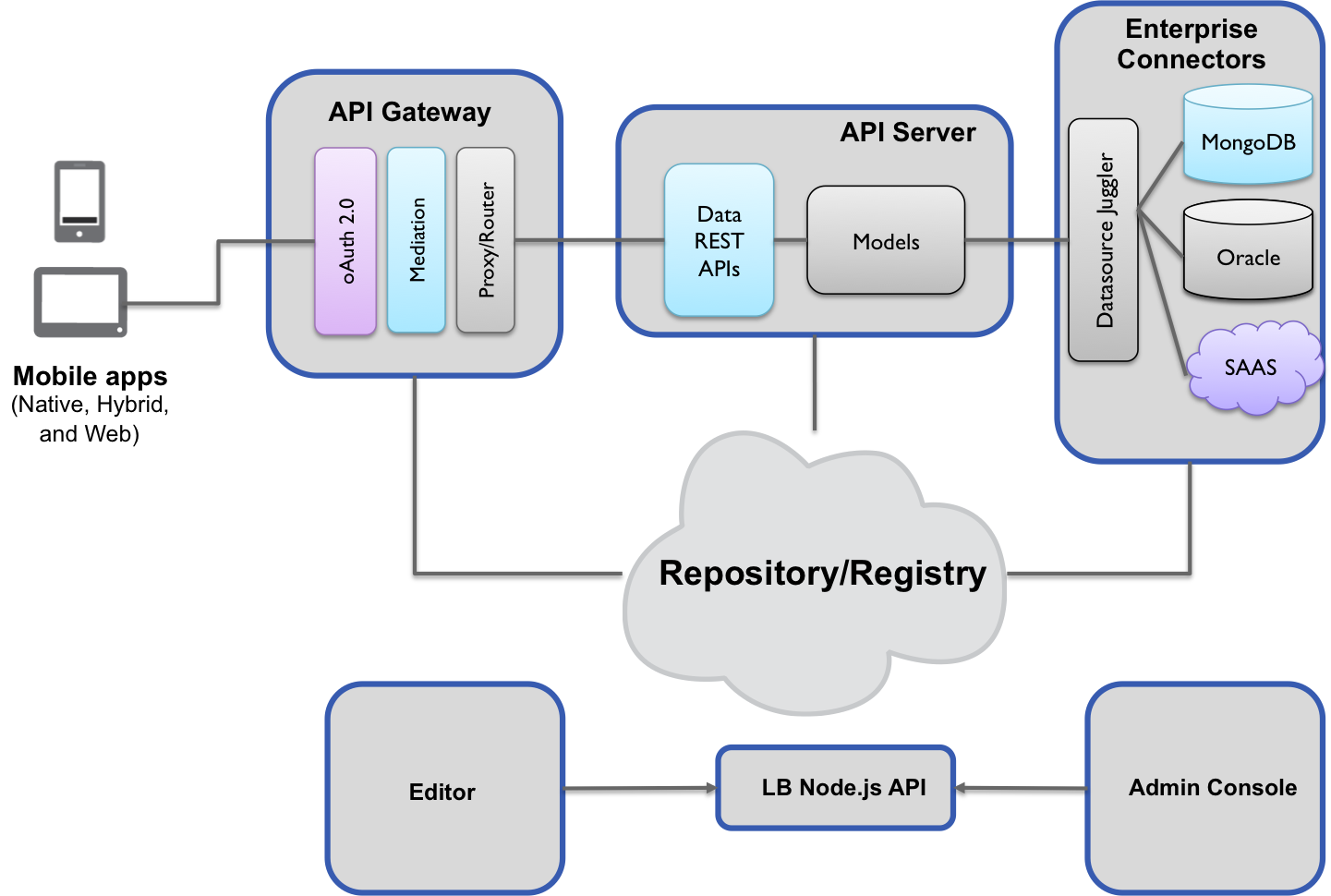9.1 KiB
Concepts
Overview
Before we go into all the wonderful concepts that make up LoopBack, let's first answer a couple of questions:
What is LoopBack?
- A component in the StrongLoop Suite.
- A library of Node.js modules for connecting mobile apps to a variety of data sources.
- A command line tool,
slc lb, for generating models and entire applications with the LoopBack library. - A set of SDKs for native and web-based mobile clients.
How does LoopBack work?
-
LoopBack applications are made up of three components: Models, Data Sources/Connectors, and the Mobile Clients that consume them.
-
Any mobile or web app can interact with LoopBack through the Model API that are backed by various data sources. The Model API is available locally within Node.js, remotely over REST, and as native mobile SDKs for iOS, Android, and HTML5. Using the API, clients can query databases, store data, upload files, send emails, create push notifications, register users, and any other behavior provided by data sources.
Mobile Clients
PLACEHOLDER FOR SDK INTRO
In summary, mobile clients work with objects that are connected to LoopBack to provide data and perform actions.Those objects are captured as models in LoopBack.
Models
What is a Model?
A LoopBack Model consists of the following:
- Application data
- Validation rules
- Data access capabilities
- Business logic
A mobile client uses the remote API provided by Models to request any information needed to display a useful interface to the user or trigger actions on the models to interact with backend systems.
Let's use a simple example to explain what a model can do for you.
Defining a model
For example, an e-commerce app might have Product and Inventory Models.
A mobile client could use the Product Model API to search through all of the
Products in a database. A client could join the Product and Inventory data to
determine what products are in stock, or the Product Model could provide a
server-side function (or remote method) that aggregates this
information.
// Step 1: Create Models
var Model = require('loopback').Model;
var Product = Model.extend('product');
var Inventory = Model.extend('customer');
NOTE: Models are schema-less by default, but some data sources, such as relational databases, require schemas. Additionally, schemas are immensely valuable for establishing the common knowledge of business data so that the data exchange can be agreed and documented while data coming from mobile clients can be validated and/or sanitized . See Sanitizing and Validating Models if your application needs to connect to an RDBMS, for example.
Attaching to Data Sources
Instances of a Model carry application data. But they are not very interesting
until applications can create, retrieve, update, or delete (CRUD) model instances.
LoopBack introduces the DataSource concept to provide the data access
capabilities to models. Attaching a Model to a DataSource gives you access to a
powerful API mixed into Models by the Connector behind a DataSource. The
MongoDB Connector, for example, mixes in a create method that allows us
to store a new Product in the database:
// Step 2: Attach Data Sources
var db = loopback.createDataSource({
connector: require('loopback-connector-mongodb')
});
// Enables the Model to use the MongoDB API
Product.attachTo(db);
// Create a new product in the database
Product.create({ name: 'widget', price: 99.99 }, function(err, widget) {
console.log(widget.id); // The product's id, added by MongoDB
});
Now the models have both data and behaviors. How can the mobile clients benefit from them? We need a way to make the models available from mobile clients.
Exposing to Mobile Clients
Models can be exposed to mobile clients using one of the remoting middlewares.
This example uses the app.rest middleware to expose the Product Model's API
over REST.
// Step 3: Create a LoopBack Application
var app = loopback();
// Use the REST remoting middleware
app.use(loopback.rest());
// Expose the `Product` model
app.model(Product);
After this, you'll have the Product model with CRUD functions working remotely
from the mobile clients. Please note the model is schema-less till now and the
data are not checked.
Sanitizing and Validating Models
A Model can be described in plain json or JavaScript. The description is called
schema. Once a schema is defined for a Model, it will validate and sanitize data
before giving it to a Data Source. For example, the Product Model has a schema
that will not change. The example below updates the Product Model with a schema
written in LoopBack Definition Language, a well-documented flavor of JSON.
// Step 4: Add a Schema
var productSchema = {
"name": { "type": "string", "required": true },
"price": "number"
};
var Product = Model.extend('product', productSchema);
On one hand, If a remote client tries to save a product with extra properties
(e.g. description), those properties will be removed before saving the Model.
On the other hand, the Model will only be saved if the product contains the
required name property.
More About Models
- Check out the Model REST API.
- Read the LoopBack Definition Language Guide.
- Browse the Node.js Model API.
- Before you build your own, check out the bundled Models.
- Expose custom behavior to clients using remote methods.
- See how to define relationships between Models.
Data Sources and Connectors
Now you see the power of LoopBack models. A model gets rich set of functions out of the box with the contribution from Data Sources and Connectors.
The concept of DataSource is introduced to encapsulate business logic to exchange data between models and various data sources. Data sources are typically databases that provide create, retrieve, update, and delete (CRUD) functions. LoopBack also generalize other backend services, such as REST APIs, SOAP Web Services, and Storage Services, as data sources.
LoopBack allows you to connect to many sources of data and services both in the cloud and on-premise in your data center. DataSources are accessed through a plugin called a Connector in LoopBack. Plugins are highly customizable and extensible. Unlike other mobile backend, LoopBack can leverage your existing data and organize them in the form of models.
Connectors implement the data exchange logic using database drivers or other client APIs. In general, connectors are not used directly by application code. The DataSource class provides APIs to configure the underlying connector and exposes functions via DataSource or model classes.
LoopBack Connector Modules
| Type | Package Name |
|---|---|
| Memory | Built-in |
| MongoDB | loopback-connector-mongodb |
| Oracle | loopback-connector-oracle |
| REST | loopback-connector-rest |
For more information, please read the LoopBack DataSource and Connector Guide.
REST
Functions defined in LoopBack Models can be made available as a REST endpoint. You can see and experiment with your REST api using the LoopBack API Explorer.
LoopBack also supports other protocols for your API as well. Socket.io is another protocol that is currently being developed.
For more information, please read Model REST APIs.
Remoting
With LoopBack you can add whatever functionality you like either by yourself or leveraging functionality from other open source modules from the community. The ability to "mix in" behaviors are available through the inherent power of Javascript's less resrictive inheritance model.
LoopBack takes this one step further by allowing you to seamlessly invoke server side code running in LoopBack in the backend from the your client on the front end.
For more information, please read the Remoting Guide.
The Big Picture
LoopBack's overall representation is illustrated below through its runtime sub-components:
- Mobile Clients
- API Gateway - Coming Soon
- API Server
- Enterprise Connectors
As well as its management sub-components:
- Editor - Coming Soon
- Admin Console - Coming Soon
- LoopBack Shell
- Repository/Registry

